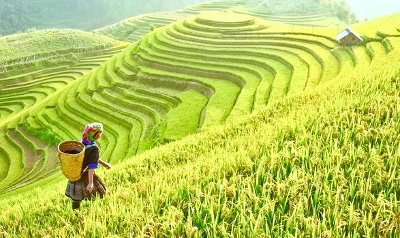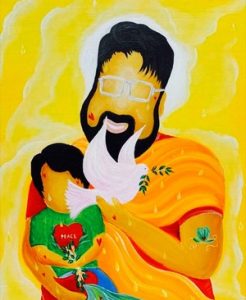They say a picture tells a thousand words.
Sometimes, a picture DOES NOT tell a thousand words.
Here in central Laos, just like in Uganda, it’s incredibly beautiful. It’s almost impossible to take a bad picture. The green hills, the exotic flowers, the golden temples, the colourful boats, the monks wearing saffron robes, the 300 foot limestone cliffs, and the florescent green rice fields, Laos is truly a gorgeous country. But just like in Africa, this natural beauty can be deceiving and mask a troubling fact, such as malnutrition.

South East Asians love rice. It’s comfort food and naturally grows in this hot, humid, and rainy climate. Specifically here in Loas, people LOVE sticky rice, and yes, that is an actual type of rice, not just a cooking accident. This national staple of sticky rice is eaten here more than any other place in the world. Approximately 155 kilograms of sticky rice is eaten, with their hands, per Laotian every year. North Americans and Europeans only eat 9 kilograms per year, and usually with a boring fork. Laotians eat it every meal. Not most meals, EVERY meal, every day, their whole life. At times, they call themselves “luk khao niaow” or “descendants of sticky rice.” For Westerners, this is fun and interesting, for the people of Lao, this can be unhealthy and even dangerous.
Some of you have kindly donated to our campaigns/fundraisers for water filters, thank you very much. Me, being the lucky one that gets to deliver, install, train, and receive the genuine thank yous from the recipients, also get interesting gifts in return. Almost always, there’s a thank you drink involved. In South America, a thank you gift is fresh juice, in the Middle East, strong coffee or tea, in Africa, a combination of 80% warm milk and 20% tea.
In Laos, 100% whisky, and of course it’s rice whisky. Home made Lao-Lao, as they call it, is powerful and known as the worlds cheapest alcohol and at times to cause blindness.

Most days, I start installing these filters and training the village elders early in the morning, which comes with sharing a thank you gift of said whisky with the village leader. I can’t be rude and turn down the only thing they have. Then on to a school for an installation with the principle and teachers, which comes with a thank you gift of more Lao-Lao. On to the health clinic and demonstrations for the doctor and nurses, and more rice whisky. Then mid afternoon, start the process again in a different village.
It’s a minor miracle that I still have sight and get through the days, but I’ll take one for humanity, whatever it takes to give the needy children of the world safe water:)
These Laotians are so thankful, and want to show their appreciation, even if all they have is rice. Here, approximately 90% of the population lives off of $1.25 a day and can only afford what’s cheapest and widely available, rice.
Unfortunately, there’s almost nothing nutritious about white rice, and especially sticky rice. In fact, its the lowest of all rice. Brown rice has fiber, vitamins, minerals, and antioxidants, sticky rice has just one component of starch, called amylopectin, and that’s it, nothing else. It’s washed 3 times and then soaked for hours, then steamed, not boiled, and takes longer to digest, which I guess the monks are happy about as they usually only eat once a day.
In addition, new mothers and babies must partake in an even unhealthier tradition of a “restricted diet”. This consists of the the new borns barely breast-fed, some never, but sticky rice given pre-chewed to the infant in the first week of life. During this time, the mother lies on a hot charcoal bed for about a month after giving birth, while avoiding fruit and vegetables, and most only eating sticky rice with salt. This ancient tradition also says that the newborn baby should not drink its mothers first breast milk, which science of course tells us that this milk is actually the most nutritious for the newborn. All of this drastically decreases the intake of iron and zinc and other vitamins a minerals, and specifically increases vitamin B deficiencies. Even though this tradition has no grain of truth to it, it’s so embedded in the culture that according to friends some new mothers will forego this tradition after heavy persuasion, but only if it was kept secret from their family and friends.
When you only earn $1.25 a day, and rice is the only thing you can afford, and with crazy traditions, it’s no wonder that 60% of the Laotian children under 5 years old are malnourished. Suzanne saw this first hand everyday at the children’s hospital where she was teaching.
Yes, Laos is beautiful. Maybe most stunning are the photos of the florescent green tiered rice patties. Something from a story book or a movie. But as you know, sometimes a picture DOES NOT tell a thousand words.
Last week, delivering water filters in northern Laos, I had the opportunity to sleep at rural traditional houses. One man, who 50 years ago was defending his country but was shot in the shoulder by a US soldier during the Vietnam war, still graciously invited this American into his house and offered a mattress on the floor and promised 3 meals a day of sticky rice. I took him up on his kind offer.
Back in our small city, every morning at 6:00 a.m. in front of our apartment, novice monks walk by, receiving their daily offerings from the neighbourhood early risers waiting out on the street. They always receive sticky rice. At 6:40, they walk back by our apartment with full bowls of this nutrition-less rice. They would always walk back faster as I’m sure they were hungry and eager to eat, as they only ate meals once or twice a day, and mostly of this unhealthy sticky rice.
I asked one of my English students, a young novice monk originally from rural Lao, but now an urban citiZEN, if instead of sticky rice he wold rather receive money to buy some healthier food? He said “yes, of course!”. So I offered him the only cash that I had at the time, a $50 bill, hoping to get a little of the money back. He looked at me and said, “change comes from within”.
Sorry, that last part was premeditated.




